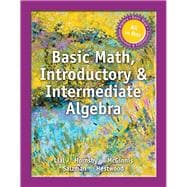The Lial Series has helped thousands of students succeed in developmental mathematics by providing the best learning and teaching support to students and instructors. The new Lial All in One, Basic Math, Introductory & Intermediate Algebra, offers everything needed to teach the full developmental math sequence in one flexible course solution, with approachable writing and pedagogy, varied exercise sets, and robust ancillary resources. A tightly integrated MyMathLab course includes the Lial Video Library, and fresh, interactive PowerPoint slides to meet the changing needs of today’s students and instructors.
ALERT: Before you purchase, check with your instructor or review your course syllabus to ensure that you select the correct ISBN. Several versions of Pearson's MyLab & Mastering products exist for each title, including customized versions for individual schools, and registrations are not transferable. In addition, you may need a CourseID, provided by your instructor, to register for and use Pearson's MyLab & Mastering products.
Packages
Access codes for Pearson's MyLab & Mastering products may not be included when purchasing or renting from companies other than Pearson; check with the seller before completing your purchase.
Used or rental books
If you rent or purchase a used book with an access code, the access code may have been redeemed previously and you may have to purchase a new access code.
Access codes
Access codes that are purchased from sellers other than Pearson carry a higher risk of being either the wrong ISBN or a previously redeemed code. Check with the seller prior to purchase.
Note: You are purchasing a standalone product; MyMathLab does not come packaged with this content. MyMathLab is not a self-paced technology and should only be purchased when required by an instructor. If you would like to purchase both the physical text and MyMathLab, search for:
9780133976830 / 0133976831 MyMathLab for Lial Basic Math, Introductory and Intermediate Algebra -- Access Card -- PLUS MySlideNotesPackage consists of:
0133931722 / 9780133931723 MySlideNotes for Lial Basic Math, Introductory and Intermediate Algebra
0321757378 / 9780321757371 MyMathLab CourseCompass Integrated Course Sequence -- Standalone Access Card
0321980379 / 9780321980373 Basic Math, Introductory and Intermediate Algebra








